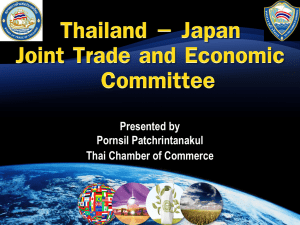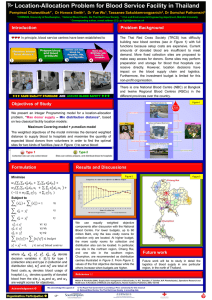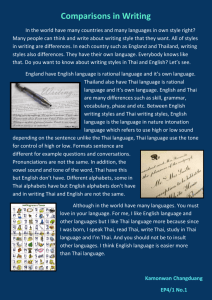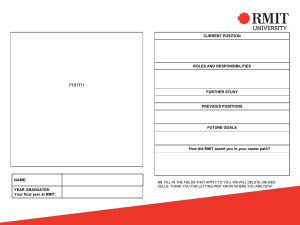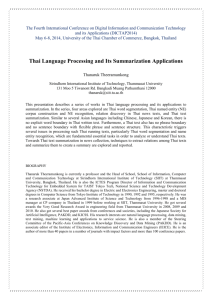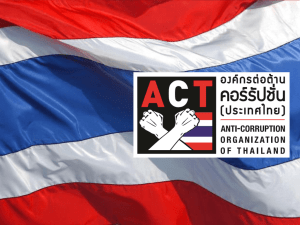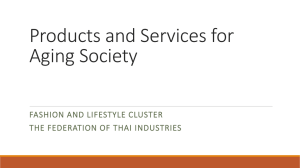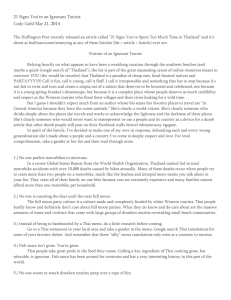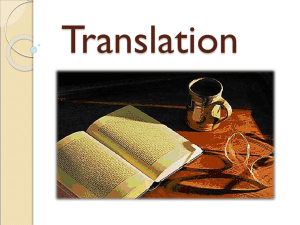Leadership and Organisational Culture in Thai
advertisement
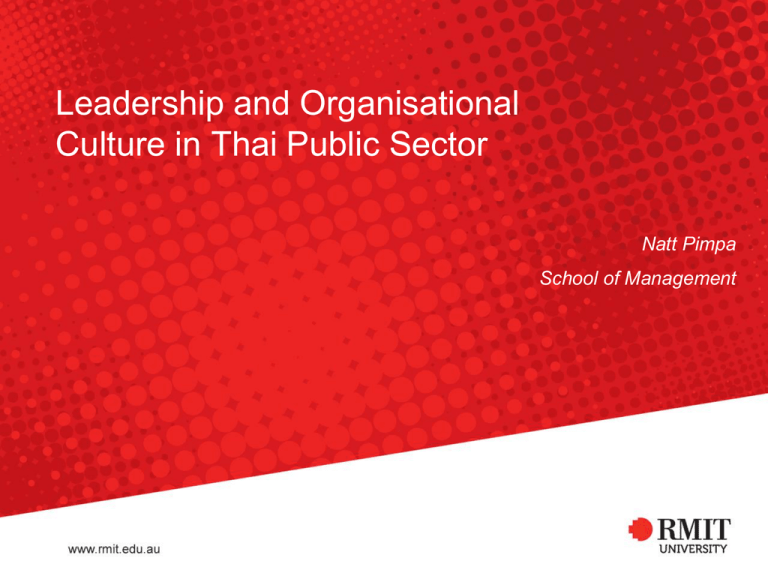
Leadership and Organisational Culture in Thai Public Sector Natt Pimpa School of Management Research Objectives • To investigate organisational culture and leadership styles in the contexts of Thai and Australian public sectors. • To compare perceptions on organisational culture between Thai and Australian public sectors. • To compare preferred leadership styles between Thai and Australian public sector officers. RMIT University School of Management 2 Methodology • Mixed-method approach • Phase 1: Questionnaire survey with 134 Thai and 150 Australian public sector officers (Ministry of Education, Ministry of Finance, Department of education and early childhood development, DFAT) • Phase 2: Personal interview with public sector leaders (33 in Thailand, 16 in Australia) RMIT University School of Management 3 Organisational Culture Orientation Australia Thailand t-value Uncertainty Orientation 2.92 3.81 16.42** Power Orientation 2.31 3.42 21.81** Group Orientation 2.14 2.92 15.06** Gender Orientation 1.43 2.35 10.97** Goal Orientation 3.53 3.67 7.73** ** = .00 RMIT University School of Management 4 Leadership Style Leadership Style Australia Thailand t-value Participative style 3.74 3.55 2.31* Conflict resolution 3.26 3.43 2.10* Task orientation 3.82 3.42 2.52* Strategic thinking 3.74 3.69 2.20* Supportive style 3.54 3.67 2.32* Customer orientation 3.72 3.60 3.45 Relationship orientation 3.12 3.76 3.89** Communication 3.44 3.54 1.34 Org. value creation 3.34 3.51 2.34 RMIT University School of Management 5 Preferred Leadership Styles Australia -Equal relationship. - Flexibility in Roles and Tasks. - Task-oriented style. -Leaders who can laugh at themselves. Thailand -Warm and Charismatic. - Show direction. - Relationship-oriented style. -Flexibility in Roles and Tasks. - Experienced. -Participative Leader. RMIT University©2010 School of Management 6 CONCEPTION 1: GODFATHER Age and experiences BoonKoon Powerful Leading through change Social connection Relationship building Formal (Amnaj) Authoritarian Warm Male (Merit) Know the system “The TAN (sir) culture remains in our public system and I believe it comes from our national culture. We were taught by our parent to study and be the boss in the future (Jao Khon Nai Khon). Who doesn’t want to be TAN?” (Suban, 52) “We like our leader to set a clear direction for us and tell us how to achieve the plan.” (Nantana, 53) “Links between leadership and Boonkoon is the fact of this country.” (Pornipa, 60) CONCEPTION 2: MADAME Female BoonKoon (Merit) Relationshiporientation • “We have a number of strong female leaders who are experienced and flexible. They deal with ‘change’ very well” (Kasem, 53). • “Most female leaders in the public system are strong and warm. They are hard-working people and are well-respected by their subordinates.” (Jintana, 49). Participative Flexible Social connection Communicativ e Relationship building Academically smart Warm Trustworthin ess Steel Magnolia (Strong&ind ependent) CONCEPTION 3: SPECIALIST Knowledge Western Managem ent Leading by example Welleducated Modern Change Wisdom Technical Smart Innovation “ Public sector reform will be successful if our leader show us the key priorities of the Ministry and draft the long-term actions and implement them” (Chaleo, 58). “I think our country need more leaders who can modernise national public sector system by injecting new techniques and approached in management” (Kasama, 58) CONCEPTION 4: POLITICIAN Flexibility Charming Well-spoken Cunning Controlled Informal Supportive Inspirational Connection Outspoken “Leaders who are flexible and smart will survive the complex of Thai public sector system.” (Chaleo, 58) “The fact that politics control our public system is sad. In my life, I have seen a number of leaders who exercised their powers through political connections and became successful.” (Kasem, 53) CONCEPTION 5: QUIRKINESS Stylish Modern Courage Visionary Peopleperson Informal Participative Radical Outspoken Fair Know the system Young “In public sector, we need someone who can challenge old ways of thinking and system.” (Chaleo, 58) “A number of young leaders in our Ministry are outspoken and radical. We love them” (Kasem, 53) Implications • There is no best leadership style in the Thai organisational context. • Thai public sector organisations tend to adopt task-orientated, supportive approaches and customer-orientated leadership styles. • The traditional types of leadership remain powerful. • An outcry for modern leadership styles. • The effects of organisational culture on leadership styles. RMIT University©2010 School of Management 12
